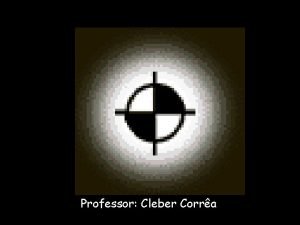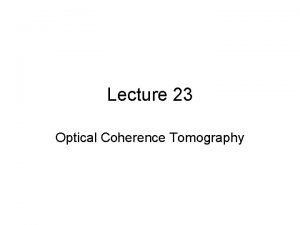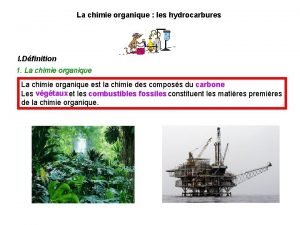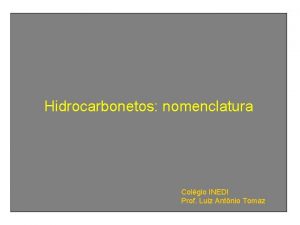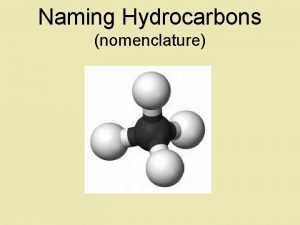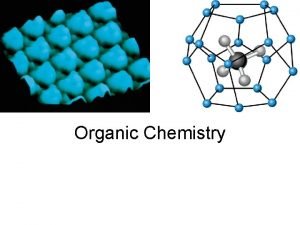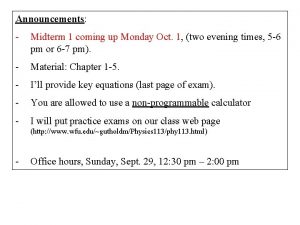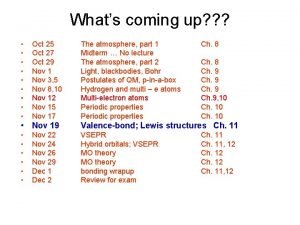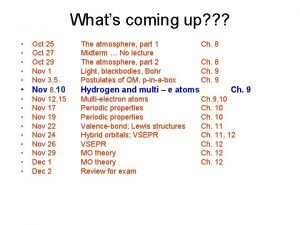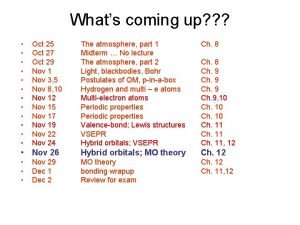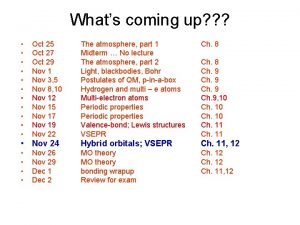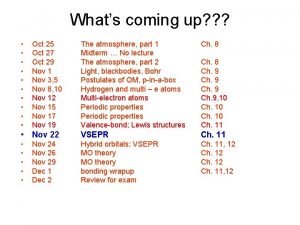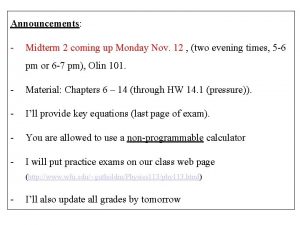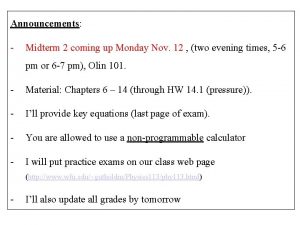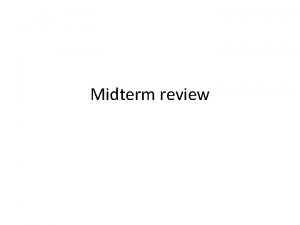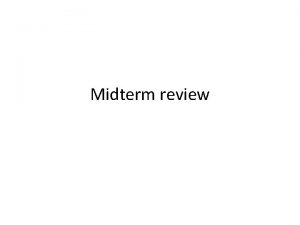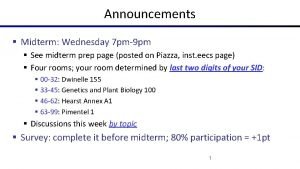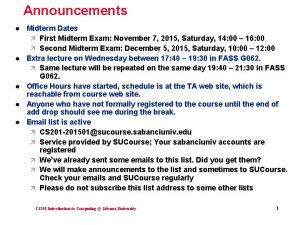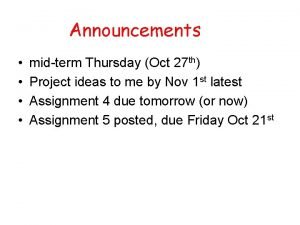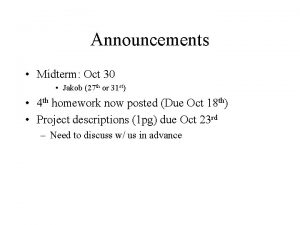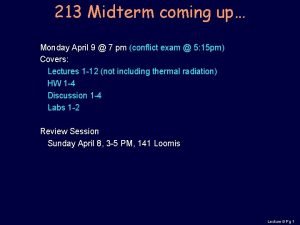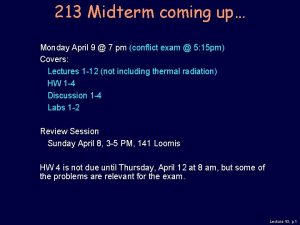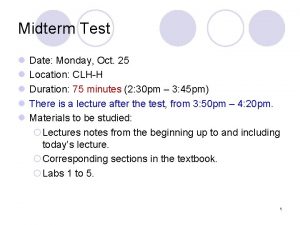Announcements Midterm 1 coming up Monday Oct 1


























- Slides: 26

Announcements: - Midterm 1 coming up Monday Oct. 1, (two evening times, 5 -6 pm or 6 -7 pm). - Material: Chapter 1 -5. - I’ll provide key equations (last page of exam). - You are allowed to use a non-programmable calculator - I will put practice exams on our class web page (http: //www. wfu. edu/~gutholdm/Physics 113/phy 113. html)

Chapter 5: The laws of motion Reading assignment: Chapter 5 Homework 5 (due Friday, Sept. 28) CQ 7, CQ 19, QQ 2, 5, 6, 18, 21, 22, 28, 32, 33, 28, 44, 55, 61, AE 1, AF (long HW, start early!) Remember: Homework 4 is due Thursday, Sept. 20. • In this chapter we will learn about the relationship between the forces exerted on an object and the acceleration of the object. • Forces • Newton’s three laws. • Free body diagrams! • Friction.

Contact forces - Involve physical contact between objects.

Field forces: -No physical contact between objects - Forces act through empty space gravity electric magnetic

Measuring forces - Forces are often measured by determining the elongation of a calibrated spring. - Forces are vectors!! Remember vector addition. - To calculate net force on an object you must use vector addition.

Newton’s first law: In the absence of external forces: • an object at rest remains at rest • an object in motion continues in motion with constant velocity (constant speed, straight line) (assume no friction). Or: When no force acts on an object, the acceleration of the object is zero. Inertia: Object resists any attempt to change is velocity i-clicker: You want to get more ketchup out of a nearly empty bottle. You turn the bottle over but the ketchup is stuck at the bottom of the bottle. Where/how should you hit the bottle so that the ketchup collects at the ‘squirt lid’? Instructor will demonstrate three options. A) Top B) side C) bottom

Inertial frame of reference: -A frame (system) that is not accelerating. - Newton’s laws hold only true in non-accelerating (inertial) frames of reference! Are the following inertial frames of reference: - A cruising car? - A braking car? - The earth? - Accelerating car?

Mass - Mass of an object specifies how much inertia the object has. - Unit of mass is kg. - The greater the mass of an object, the less it accelerates under the action of an applied force. - Don’t confuse mass and weight (see: bit later). From: physics. nist. gov

Newton’s second law (very important) The acceleration of an object is directly proportional to the net force acting on it and inversely proportional to its mass.

Unit of force: • The unit of force is the Newton (1 N) • One Newton: The force required to accelerate a 1 kg mass to 1 m/s 2. • 1 N = 1 kg·m/s 2 Isaac Newton, 1643 – 1727 (English physicist, mathematician, astronomer, philosopher, theologian) One of the most influential scientists and people in human history. His work laid the foundation of most of classical mechanics. Also built the first practical telescope, developed (with Leibniz) differential and integral calculus Portrait by Godfrey Kneller (1689) http: //en. wikipedia. org/wiki/Isaac_Newton

Black board example 5. 1 F 2 = 8. 0 N (related to HW problem) q 2 = 60° Two forces act on a hockey puck (mass m = 0. 3 kg) as shown in the figure. F 1 = 5. 0 N q 1 = - 20° (a) Determine the magnitude and direction of the net force acting on the puck. (b) Determine the magnitude and the direction of the pucks acceleration. i-clicker: A) 0 o B) 31 o Direction of acceleration: C) 61 o D) 90 o E) 45 o

The force of gravity and weight • Objects are attracted to Earth. • This attractive force is the force of gravity Fg. • The magnitude of this force is called the weight of the object. • The weight of an object is, thus m·g.

Newton’s third law “For every action there is an equal and opposite reaction. ” If two objects interact, the force F 12 exerted by object 1 on object 2 is equal in magnitude and opposite in direction to the force F 21 exerted by object 2 on object 1: Action and reaction forces always act on different objects.

Conceptual example: A large man, (m = 100 kg) and a small boy (m = 50 kg) stand facing each other on frictionless ice. They put their hands together and push against each other so that they move apart. Who experiences the larger force? larger acceleration? larger speed? (after they are separated) A. B. C. D. The boy The man Same for both Need more info

Where is the action and reaction force? Normal force – support force acting normal (perpendicular) to surface What forces are acting on the TV?

Black board: Free body diagram • Identifying and analyzing all forces that act on an object • Constructing a free body diagram • Tension in a rope = magnitude of the force that the rope exerts on object.

Applying Newton’s laws 1. Make a diagram (conceptualize) 2. Categorize: no acceleration: accelerating object: 3. Isolate each object and draw a free body diagram for each object. Draw in all forces that act on the object. 4. Establish a convenient coordinate system. 5. Write Newton’s law for each body and each coordinate component. set of equations; solve 6. Finalize by checking answers.

Black board example 5. 2 (on HW) A traffic light weighing 125 N hangs from a cable tied to two other cables fastened to a support as shown in the figure. Find the tension in the three cables.

Black board example 5. 3 (on HW) A crate of mass m is placed on a frictionless plane of incline a = 30. (a) Determine the acceleration of the crate. (b) Starting from rest, the crate travels a distance d = 10. 2 m to the bottom of the incline. How long does it take to reach the bottom, and what is its speed at the bottom? a a

Black board example 5. 4 Attwood’s machine. Two objects of mass m 1 = 2. 00 kg and m 2 = 4. 00 kg are hung over a pulley. (a) Determine the magnitude of the acceleration of the two objects and the tension in the cord.

Forces of Friction • Static friction, fs • Kinetic friction, fk Friction is due to the surfaces interacting with each other on the microscopic level. • sliding over bumps • chemical bonds time

The following empirical laws hold true about friction: - Friction force, f, is proportional to normal force, n. - ms and mk: coefficients of static and kinetic friction, respectively - Direction of frictional force is opposite to direction of relative motion - Values of ms and mk depend on nature of surface. - ms and mk don’t depend on the area of contact. - ms and mk don’t depend on speed. - ms, max is usually a bit larger than mk. - Range from about 0. 003 (mk for synovial joints in humans) to 1 (ms for rubber on concrete). See table 5. 2 in book.

Approximate friction coefficients Rubber on concrete Wood on wood Waxed wood on wet snow Synovial joints in humans ms mk 1. 0 0. 8 0. 25 -0. 5 0. 2 0. 14 0. 1 0. 003

Black board example 5. 5 (related to HW) Measuring the coefficient of static friction A brick is placed on an inclined board as shown in the figure. The angle of incline is increased until the block starts to move. a a Determine the static friction coefficient, ms, from the critical angle, ac, at which the block starts to move. Calculate ms for ac = 26. 5°.

Black board example 5. 6 (on HW) A car is traveling at 50. 0 mi/h on a horizontal highway. (a) If the coefficient of kinetic friction and static friction between road and tires on an icy day are 0. 080 and 0. 1, respectively, what is the minimum distance in which the car can stop? (b) What are the advantages of antilock brakes?

i-clicker: If an object is in force equilibrium (Fnet = 0), which of the following statements follow necessarily (are always true when Fnet = 0)? A) B) C) D) E) The velocity of the object is constant. The acceleration of the object is not zero. The object is not moving. Only one force is acting on the object. A) and D)
 Nanosystem fabrication facility
Nanosystem fabrication facility What two announcements did montag hear
What two announcements did montag hear Pvu background
Pvu background Kayl announcements
Kayl announcements R/announcements!
R/announcements! General announcements
General announcements Church announcements
Church announcements Scleral lens oct
Scleral lens oct Met et prop but pent hex hept oct non dec
Met et prop but pent hex hept oct non dec Prop but pent hex hept oct
Prop but pent hex hept oct Principle of oct
Principle of oct What is chemistry
What is chemistry 5 characteristics of homologous series
5 characteristics of homologous series Jhlt. 2019 oct; 38(10): 1015-1066
Jhlt. 2019 oct; 38(10): 1015-1066 Mahatma gandhi life story
Mahatma gandhi life story Caucho sintetico
Caucho sintetico C10h22oh
C10h22oh Prop but pent hex hept oct
Prop but pent hex hept oct Propylhexane formule semi-développée
Propylhexane formule semi-développée Erg vizsgálat
Erg vizsgálat Hidrocarbonetos ramificados
Hidrocarbonetos ramificados Jhlt. 2019 oct; 38(10): 1015-1066
Jhlt. 2019 oct; 38(10): 1015-1066 Ims design software
Ims design software Działania na systemach liczbowych
Działania na systemach liczbowych Mnemonic for hydrocarbons
Mnemonic for hydrocarbons Alkane alkene alkyne
Alkane alkene alkyne Oct 31st sunset
Oct 31st sunset








